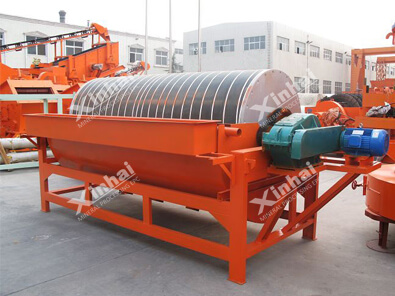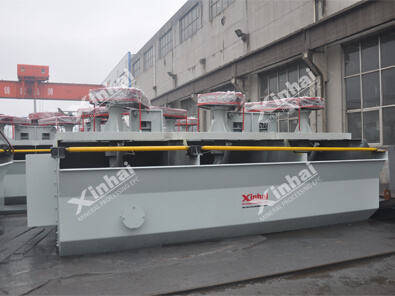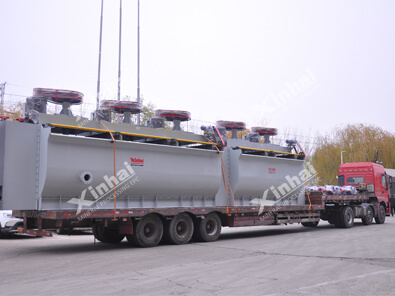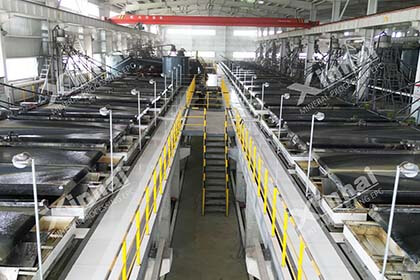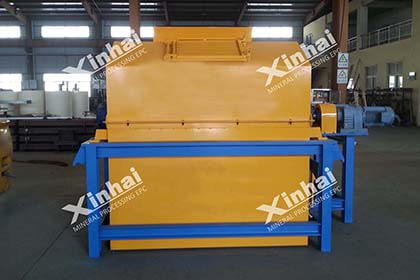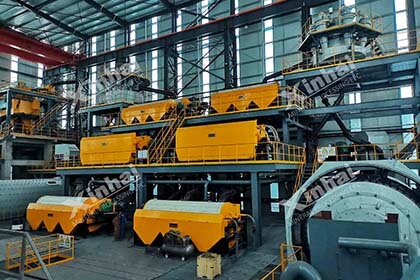6 Methods for Removing Iron From Silica Sand
 Shirley
Shirley
 Nov 30, 2021
Nov 30, 2021
 4607
4607
If you want to know more details about equipment, solutions, etc, please click the button below for free consultation, or leave your requirements!

The iron impurities in silica sand mainly exist in various forms such as muscovite, pyrite and iron oxides. The existence of iron impurities greatly reduces the use value of silica sand and affects the quality of products. Therefore, it is very important to remove iron from silica sand. This article will take you to learn more about these 6 methods of iron removal from silica sand.
01 Iron Removal by Mechanical Scrubbing
BackMechanical scrubbing is to remove the thin film iron on the surface of the silica sand and the iron-containing minerals adhering to the surface of the silica sand by means of mechanical external force and the collision and friction between the sand particles. At present, scrubbing techniques are mainly scrubbing by rod mill and mechanical scrubbing.
The efficiency of mechanical scrubbing increases as the slurry concentration increases. Research shows that placer scrubbing concentration is between 50% and 60% for the best effect. In principle, the scrubbing time is based on the initial product quality requirements, and should not be too long. Because the time is too long, it will increase equipment abrasion, increase energy consumption and increase the cost of beneficiation.
Compared with other iron removal processes, the scrubbing process has the following characteristics:
Good product quality, which can meet the quality requirements for high-quality silica sand;
Large output. Now some small-scale production enterprises use this method to remove iron more because of its low cost and simple operation, but the iron removal rate is relatively low.

(High-Efficient agitating scrubbing machine for sale)
02 Iron Removal by Magnetic Separation
BackIn the magnetic separation process, the wet-type strong magnetic separator can remove the weakly magnetic impurity minerals such as hematite, limonite and biotite including conjoined particles to the maximum.
Generally speaking, silica sand mainly containing weakly magnetic impurity minerals can be separated using a wet-type strong magnetic separator at a temperature above 10,000 oersteds; for strong magnetic minerals containing mainly magnetite impurities, a weak or medium magnetic separator is better.
The more times of magnetic separation, the finer the grain size of silica sand and the better the iron removal effect.

(Magnetic separator for silica separation)
03 Iron Removal by Flotation
BackFlotation is mainly used to separate feldspar from silica sand, and can also be used to remove clay minerals such as mica and secondary iron from silica sand. The most typical process is to use hydrofluoric acid as the activator, and use an amine cationic collector for flotation under strong acidity (pH=2~3).
Flotation methods can be divided into three types:
The first is the method with fluorine and acid. This method is widely used because of its good flotation effect, easy control and stable index. However, the erosion effect of fluoride ion on the land and the damage to the surrounding ecological environment are great.
The second is the fluoride-free acid method. The biggest advantage of this method is to avoid the use of fluoride ions, which have a destructive effect on the environment, and the production index is stable, but the corrosive effect of strong acid on the mineral processing equipment cannot be ignored. There are higher requirements for flotation equipment.
The third is the fluorine-free and acid-free method. Under natural pH conditions, a unique high-concentration pulp flotation environment is created through the reasonable allocation of anion and cation collectors to achieve the purpose of preferential flotation of impurity minerals. However, because this method has strict requirements on raw sand processing and pulp environment, it is not easy to control in production, and it has not been widely used at present.
Flotation has a good effect on removing iron contained in heavy minerals.
(Flotation machine ready for shipment)
04 Iron Removal by Acid Leaching
BackAcid leaching utilizes the characteristics that quartz is insoluble in acid (except HF) and other impurity minerals can be dissolved by acid, so as to achieve further purification of quartz. Acids commonly used in acid leaching include sulfuric acid, hydrochloric acid, nitric acid and hydrofluoric acid; reducing agents include sulfurous acid and its salts.
Studies have found that the above-mentioned acids have a good removal effect on non-metallic impurities in quartz, but they have a significant effect on different metal impurities, acid types and their concentrations. It is generally use dilute acids to remove Fe and Al, and use concentrated sulfuric acid, aqua regia or HF to remove Ti and Cr. Considering the dissolving effect of HF on quartz, the HF concentration generally does not exceed 10%.
In addition to the concentration of acid, the amount of acid, acid leaching time, temperature and slurry mixing can all affect the quartz acid leaching effect. The control of various factors of acid leaching should be based on the requirements of the final grade of quartz, try to reduce the acid concentration, temperature, dosage, and the acid leaching time, so as to achieve quartz purification at a lower beneficiation cost. After acid leaching, high purity quartz can be obtained with a purity of 99.99%.
Generally speaking, the use of sulfuric acid, hydrochloric acid, nitric acid and hydrofluoric acid is expensive and has a great impact on the environment. Oxalic acid is used to react with Fe³⁺ on the surface of the mineral particles to form a complex and then dissolve in water to achieve the purpose of iron removal. The main advantage of using oxalic acid to remove iron is that a soluble complex is formed during leaching, which can be decomposed under the action of microorganisms and sunlight.

(Acid leaching production workshop)
05 Iron Removal by Ultrasonic Waves
BackThe ultrasonic iron removal process uses ultrasonic waves to generate shock waves in water. The shock waves make the iron-containing impurities on the surface of the silica sand particles separate into the solution to achieve the purpose of iron removal. Ultrasonic iron removal can effectively remove the secondary iron film on the surface of the silica sand particles, but its process is relatively expensive, and it is mostly used in the high value-added, precision silicon industry.
06 Iron Removal by Microorganism
BackMicrobial iron removal is a newly developed technology, currently in the research stage of laboratories and small-scale experiments. The research report pointed out that microorganisms such as bacteria and molds have a good effect on iron removal from silica sand, and Aspergillus niger has the best iron removal effect. In the second stage of beneficiation, the silica sand is immersed in the culture solution at a temperature of 90 ℃, which can reduce the content of Fe₂O₃ in the silica sand to 0.012%, which is very suitable for the production of high-quality glass.
07To Sum Up
BackIn actual production, various physical and mechanical methods and chemical methods can be used alone or in combination to remove iron from silica sand, and their efficiency largely depends on the nature of the processed mineral raw materials. If you have any questions about the iron removal of silica sand, please leave a message to communicate with us, or consult our online customer service.
 +86 18716000713
+86 18716000713 xlyin@xinhaimining.net
xlyin@xinhaimining.net




 Message
Message Chat Now
Chat Now



